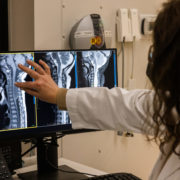
March is National Cheerleading Safety Month and the perfect time to talk about how this fun sport can sometimes lead to painful injuries. USA Cheer uses this opportunity to educate parents and athletes about cheerleading injuries. If you have a child participating in cheer, take steps to keep them safe with the preventative measures this blog explains.
The Need for Safety in Cheer
Sports injury prevention is vital for all young athletes. An injury can be painful, and it can sideline your child for days, weeks, or even a season. Some sports injuries even cause lasting damage.
Cheerleading has become more complex and gymnastic-like in recent years, increasing the potential for accidents and injuries. According to studies, participation in cheer is on the rise, and with it, the number of incidents that lead to injury. As the sport evolves to include more difficult stunts, safety and prevention are more important than ever.
The Most Common Cheerleading Injuries
Overuse and accident-based injuries are the two most common injuries that cheerleaders have. An overuse injury results from repeating a movement over and over again. For instance, cheerleaders may develop spinal overuse injuries from repeated back hyperextensions.
On the other hand, accidents are one-time events that can cause anything from a pulled muscle to broken bones.
The most common accident-based cheerleading injuries include:
- Strains and sprains. A strain damages a muscle or tendon, the tissue that connects bone and muscle. A sprain affects ligaments in the joints. Cheerleaders are especially vulnerable to ankle and knee sprains and muscle strains in the back and legs.
- Hand and wrist injuries. Falls are all too common in cheer. Landing on a hand or wrist can cause a sprain or broken bones.
- Fractures. A fracture, or bone break, is a more severe injury in cheer. A broken bone typically ends the athlete’s season.
Safety Tips to Prevent Cheerleading Injuries
 Cheerleading does not have to be so dangerous, and prevention goes a long way toward making this a safer sport. If you have a child dedicated to cheer, make sure they, and their coaches, follow proper safety protocols.
Cheerleading does not have to be so dangerous, and prevention goes a long way toward making this a safer sport. If you have a child dedicated to cheer, make sure they, and their coaches, follow proper safety protocols.
Train and Condition
Many cheer injuries result from weak muscles or muscle imbalances. Proper physical conditioning prepares the body for stunts and reduces the risk of repetitive strain and other injuries. Young athletes participating in cheer should practice regular strength training focusing on the core for stability. They should also do cross-training to minimize overuse injuries.
Stretch and Warm-Up
As with any sport, a warm-up session is essential to injury prevention. Stretching and light cardio warms up the muscles and increases joint mobility. Trying to do the difficult cheer stunts and movements with tight muscles and joints can trigger an injury.
Practice Good Form
Proper technique and form are essential to limit injuries. Coaches are responsible for teaching young athletes good form. They should also limit any participant’s stunts and movements until they have prepared to do them correctly.
Follow the Rules
USA Cheer outlines rules for every age group and competition level. Many of these aim to improve safety for athletes. For example, there are strict rules for performing a pyramid, one of the most dangerous cheerleading formations.
Know the rules so you can ensure your child is participating safely. Speak up if you see the organization or a coach breaking safety rules.
Work with Professionals
Never let your child participate in a cheer program without knowing the coaches and their qualifications. Coaches should be certified in safety at a minimum, but USA Cheer offers many additional credentials. An unqualified coach is dangerous, even if they have personal experience in the sport.
It is also a good idea to have a good sports medicine team to work with if your child gets injured in cheerleading. Preventing cheerleading injuries is ideal, but they will need good urgent care if they get hurt.
Cheerleading is a fun, popular sport, and it has become more competitive than ever, with increasingly complex and dangerous stunts. Your child can still enjoy cheer, but be aware of safety issues.
If they get hurt, find out how EmergeOrtho—Triangle Region can help. We encourage you to schedule an appointment. Or, call us any time at (919) 220-5255.







